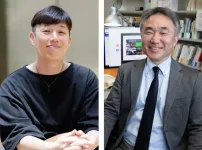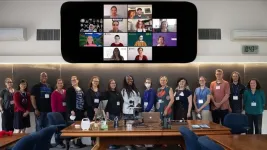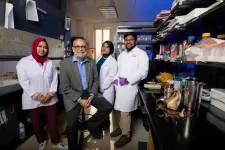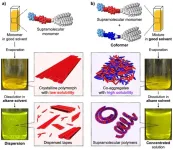Unraveling autism spectrum disorder mechanisms through rigid-autonomous phase sequences
Researchers pave the way for innovative treatments for autism spectrum disorders by building on Hebb’s theory of the mind.
2023-11-21
(Press-News.org)
This study delves into the behavioral complexities of autism spectrum disorder (ASD) by introducing the rigid-autonomous phase sequence (RAPS) formation concept. RAPS are may be responsible for the cognitive, sensory-motor, and memory-related challenges faced by individuals with ASD. By uniting these insights under a single theoretical framework, this research paves the way for innovative treatments, promising a brighter future for those with ASD.
Autism spectrum disorder (ASD) is a complex neuropsychiatric condition, marked by diverse cognitive and sensorimotor challenges, difficulties with social communication, and distinct behavioral patterns. While genetic factors are known to play a role, the intricate mechanisms driving this condition remain elusive. Moreover, a unified and comprehensive theoretical framework that can explain behavioral abnormalities associated with ASD is lacking. In a study published online in Perspectives on Psychological Science on November 1, 2023, Professor Kenkichi Takase from the Department of Psychology, Chuo University, Japan and Professor Eiichi Nojiri from the Graduate School of Human Sciences, Osaka University, Japan, expanded on the pioneering work of psychologist Donald Olding Hebb to explore underlying mental functionalities and their role in ASD. Their work sheds light on the intricate connections within the brain by aiming to bridge existing gaps in our understanding of the neurodevelopmental condition.
Hebb's insights focused on the animistic nature of the mind, emphasizing that higher mental functions, such as learning, memory, and attention, are deeply rooted in the activities of the nervous system. These insights offered a comprehensive explanation for the generalization of perceptual learning, memory stability, and attention variability, forming a coordinated pattern of neural change.
But how does Hebb's theory relate to autism ASD? This study picks up where Hebb's work left off. “We have extended the Hebb's theory, which showed how the mind works in the brain, to determine the cause of ASD,” Prof. Takase and Nojiri states. Researchers theorize that individuals with ASD exhibit an altered state of neural connections, which they refer to as RAPS. Unlike flexible neural pathways that allow for adaptability, RAPS can lead to cognitive, sensory-motor, and memory-related disorders. One can think of RAPS in the brain like train tracks that have become stuck in one direction. This inflexible track makes it difficult for individuals with ASD to learn new things as the train is always arriving at the same station. It also causes the brain to remember certain things very well, like vividly recalling specific objects or events. This unique brain pattern, characterized by its inflexibility, has the potential to explain many of the challenges individuals with ASD face in their daily lives.
This paper proposes that RAPS can explain a wide range of symptoms in individuals with ASD, encompassing social, cognitive, and motor difficulties. The theory suggests that RAPS interferes with the activation of other neural circuits, leading to the observed impairments in various functions. Hence, the concept of RAPS can serve as a theoretical framework to understand the underlying neural mechanisms that contribute to the diverse symptoms associated with ASD.
These discoveries carry immense potential for reshaping our understanding of ASD, offering a unifying framework that transcends earlier models. By explaining the vast array of symptoms associated with ASD through the lens of RAPS, the theory opens doors for the development of innovative treatments targeting these neural patterns. “If the cause of ASD can be identified, treatments for ASDs that were previously untreatable, may be found,” Prof. Takase concludes. The findings inspire the autism research community to delve deeper into this novel perspective, fostering the development of interventions aimed at enhancing the lives of individuals with ASD.
In essence, this study illuminates the possibility of more impactful therapies, instilling hope for a promising future for individuals within the autism spectrum.
About Professor Kenkichi Takase (on the left)
Kenkichi Takase, a distinguished expert in clinical developmental biopsychology at Chuo University, Japan, is renowned for his groundbreaking research on the interplay of biological, psychological, and social factors leading to sex-specific abnormal behaviors in specific developmental stages. Utilizing rats and mice as essential animal models, his studies have resulted in numerous publications with over 5,691 reads and 881 citations. Professor Takase's work significantly contributes to the understanding of complex behaviors, shedding light on the critical aspects of human and animal development. His innovative research continues to shape the field, inspiring future investigations in the realm of biopsychology.
About Professor Eiichi Nojiri (on the right)
Eiichi Nojiri, a prominent philosopher at Osaka University's Laboratory of Comparative Study of Civilizations, is known for his innovative research style that examines human nature from an interdisciplinary perspective. In recent years, Professor Nojiri has been particularly well known in Japan as the leader of a collaborative research group on autism spectrum disorders with researchers from a range of disciplines. In 2019, he edited a book entitled Introduction to Autism Studies by scholars from eighteen academic disciplines, and in 2022 he successfully organized a large-scale metaverse event “Autism Studies Hyper-Conference!” involving academic researchers, companies, nonprofit organizations, people with developmental disabilities, and lay participants. He provides the basic theoretical backbone and core philosophical concepts for this paper.
END
[Attachments] See images for this press release:


ELSE PRESS RELEASES FROM THIS DATE:
2023-11-21
Success in science, technology, engineering, and mathematics (STEM) demands keeping up with the latest tools and techniques. The AI boom, for example, has made coding and data management skills integral. But going back to school isn’t an option for most scientists. Short training programs like webinars and boot camps have become a popular alternative among busy STEM professionals. However, these formats can have significant shortcomings. There’s often no guarantee attendees will leave with the skills needed to advance their careers. And they can be exclusionary, preventing learners of all abilities and circumstances from benefiting equally.
“We’ve ...
2023-11-21
EL PASO, Texas (Nov. 21, 2023) – Neurodegenerative disorders, including Alzheimer’s, Parkinson’s and Huntington’s, affect millions of people in the United States, and the cost of caring for people who live with these conditions adds up to hundreds of billions of dollars each year.
Now, researchers from The University of Texas at El Paso may potentially have found a solution in used coffee grounds — a material that is discarded from homes and businesses around the world every day.
A team led by Jyotish Kumar, a doctoral student in the Department of Chemistry and Biochemistry, and overseen by Mahesh ...
2023-11-21
Gender stereotypes harm people of both genders—and society more broadly—by steering and sometimes limiting people to behaviors, roles, and activities linked with their gender. Widely shared stereotypes include the assumption that men are more central to professional life while women are more central to domestic life. Other stereotypes link men with math and science and women with arts and liberal arts. Perhaps surprisingly, research has shown that countries with higher economic development, individualism, and gender-equality tend to also have more pronounced gender differences in several domains, ...
2023-11-21
Supramolecular polymers (SPs) are molecular assemblies composed of non-covalently bonded small molecules. They show high recyclability originating from their dynamic nature of monomer binding, which is different from covalent polymers with non-biodegradable nature. The small repeating units that form SPs, called monomers, are specifically designed to construct multiple non-covalent bonds to enhance the stability of the resulting SPs. Such monomers can be organized into structurally distinct assemblies by forming various ...
2023-11-21
Osaka, Japan – To age or not to age! How does aging affect organisms on a cellular level? What mechanisms help cells survive self-inflicted or external harm? It is known that lysosomes—critically important cellular structures—are crucial for digesting damaged cellular components and pathogens, and maintain stability within cells and tissues. But can they also be repaired, and if so, how?
In a study published this month in EMBO Reports, researchers from Osaka University and Nara Medical University have shown that damaged lysosomes are repaired by a mechanism called “microautophagy” and have identified two key regulators of this ...
2023-11-21
Mount Sinai Health System announced that Brendan Carr, MD, MA, MS, a nationally recognized leader in academic medicine and health policy, will be its next Chief Executive Officer.
Dr. Carr joined Mount Sinai as its head of emergency medicine in February 2020, just before New York City became the initial epicenter of the COVID-19 pandemic in the United States. He played a critical role during the pandemic and led local, regional, and national initiatives focused on improving the Health System’s emergency and critical care capacity. He was ...
2023-11-21
SEATTLE, WASH.—November 21, 2023—Uncovering biological properties of extracellular vesicles, which play a vital role in how cells communicate, and understanding how sex hormones drive behavior and development are two areas that the new cohorts of Allen Distinguished Investigators will research, thanks to over $10 million in funding from the Paul G. Allen Family Foundation. The 18 researchers will develop technologies, design approaches, and uncover insights into fundamental areas of human biology.
2023 Allen Distinguished Investigators
Kenneth Witwer, ...
2023-11-21
CHICAGO – A newly developed artificial intelligence (AI) system that analyzes specialized MRIs of the brain accurately diagnosed children between the ages of 24 and 48 months with autism at a 98.5% accuracy rate, according to research being presented next week at the annual meeting of the Radiological Society of North America (RSNA).
Mohamed Khudri, B.Sc., a visiting research scholar at the University of Louisville in Kentucky, was part of a multi-disciplinary team that developed the three-stage system to analyze and classify diffusion tensor MRI (DT-MRI) of the brain. DT-MRI is a special technique that detects how water travels along white matter tracts in the brain.
“Our ...
2023-11-21
CHICAGO – Soccer fans exhibit different patterns of brain activation while watching a match that may trigger positive and negative emotions and behaviors, according to research being presented next week at the annual meeting of the Radiological Society of North America (RSNA). The researchers say the implication of these findings could extend beyond sports to fanaticism in other areas, such as politics.
“This study aims to shed light on the behaviors and dynamics associated with extreme rivalry, aggression and social affiliation within and between groups of fanatics,” said the study’s lead author, Francisco Zamorano ...
2023-11-21
Using artificial intelligence technology and mathematical modeling, a research group led by Nagoya University has revealed that human behavior, such as lockdowns and isolation measures, affect the evolution of new strains of COVID-19. SARS-CoV-2, the virus that causes COVID-19, developed to become more transmissible earlier in its lifecycle. The researcher’s findings, published in Nature Communications, provide new insights into the relationship between how people behave and disease-causing agents.
As with any other living organism, viruses evolve over time. Those with survival advantages become dominant in the gene pool. Many environmental factors ...
LAST 30 PRESS RELEASES:
[Press-News.org] Unraveling autism spectrum disorder mechanisms through rigid-autonomous phase sequences
Researchers pave the way for innovative treatments for autism spectrum disorders by building on Hebb’s theory of the mind.










